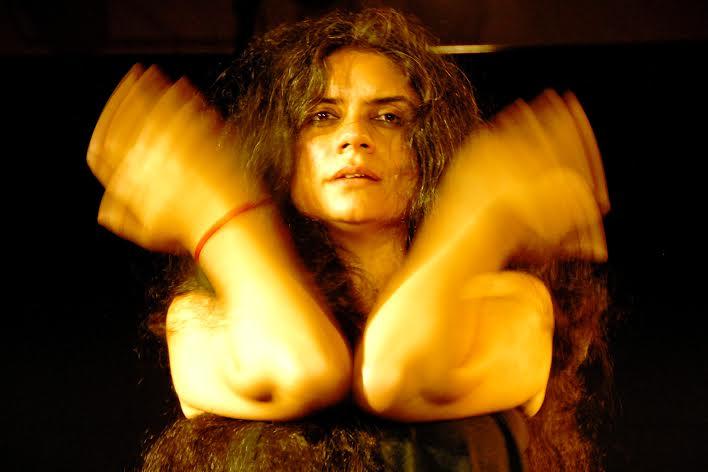 nil
nil
The cup that cheers
Notes on Chai , a performance by Mumbai based Jyoti Dogra uses abstract ideas and real-life performance where the audience plays a vital role. She shares her thoughts on this unusual experiment with tea with Shoma A. Chatterji
In Notes on Chai, solo artiste Jyoti Dogra has turned the ritual of tea-drinking, a rather mundane activity, on its head to make a strong, socio-political statement on contemporary life, relationships, and human interaction making optimum use of not only her body but also her vocal elements. Her abstract theatre is not really abstract. The performance is real but the presentation is a blend of the abstract and the concrete.
How did you hit on this simple title Notes on Chai as subject of your performance ?
Chai is a repeated metaphor. Philosophers, thinkers, writers, dhabawallahs, sweepers all are hooked on chai. This basic universality set off the trigger. Tea works as a springboard that moves into other issues—there is a shift from the seemingly superficial to an addressing of deeper insecurities and fears that one does not speak of directly.
Tea is central to my performance because it is not just the cup that cheers. Tea is an agency that brings and keeps people together. Tea keeps you company when you are lonely, depressed, or even happy and overjoyed. It offers a journey to dwell on nostalgia and to dream about the future. At some point along the way, it liberates itself from the confines of the worldly cup to travel yonder. It becomes abstract because it is an idea and a concept and much more than just a cup of addictive drink.
Your conception of language and speech is unconventional.jpg)
Language does not always foster communication - it often creates distances. Sure, exchange of words is happening, but you keep a polite distance, not divulging your true feelings, your inner life and your experiences.
You create sound through your throat, tongue, lips in strange ways and as the performance proceeds, one feels you are using them as markers to separate one character from the next
For me, the audience is not one unified and collective body. There is space for every individual member. Someone may find one bit comic while another might not find it funny. Someone else might find it filmy. The deeper participation happens when a member is alone in the piece with me. My breaking of the fourth wall also constructs the fourth wall - the alienation of the audience from the actor that stops the audience from intruding into the performing space. Each member participates when he/she connects and finds his/her everyday with the mundane routine of life.
What is the purpose of your experiments with sounds emanating from your vocal and speech systems?
It is entirely personal. What you make of the sound as a member of the audience is yours. I am trying to change the power-equations between the audience and the performer. How I construct it is my version, how you, as audience perceive it is yours. This means that you are actually making meaning with me.
You trained in the school of Tibetan-Buddhist chants that you use generously through your performance. This originates in the spiritual. But your use of it is aimed at the mundane and the everyday. Why?
Everyday chores such as trying to negotiate the traffic, cooking, even politics eat up your time. My performance is divided into two styles - one is created through sounds and the other uses the mundane. For instance, I ask a member of the audience what is the time now. I am always making you shift on your seat, making you try to understand what I am doing and why and trying to pin it down. I am challenging myself as a performer making the audience shift from one interpretation to another. This is how my performance has evolved. The sounds, the chants, the silences express the abstract from the spiritual world. Language on the other hand is concrete.
What makes you focus on the actor’s body, voice, silence etc to create your content rather than a plot, story, original play?
It is physical style which interests me the most as I am basically a performer, an actor. This kind of performance focusses mainly on the inner and outer life of the actor and not on the playwright’s or the director’s vision. The acting craft within this conventional form relegates the position of the actor and the very craft of acting is subjected to what the play demands. But I strongly believe that a living person has enough material to create a performance with his body, his voice, his use of space, his costume and fluidity to make improvisations if and when needed..jpg)
You do not seem interested in pursuing cinema and television though you have done quite a few films and television serials
The same reason more or less as given above. In cinema, an actor’s performance can and is always being manipulated by the technique of cinema – editing, cinematography, etc so where does this leave an actor? Theatre offers more freedom and access both to the actor and to the audience.
Top Headlines
-
Art and Culture
Saptak Music School of Pittsburgh hosts spellbinding evening of Indian classical music
September 23, 2025
-
Art and Culture
Zigzag to clarity: Sonal Mansinghs dance of life captivates Delhi
September 08, 2025
-
Art and Culture
USA: Santoor Ashram Kolkata mesmerises Los Angeles with a celebration of Indian classical music
August 27, 2025
-
Art and Culture
'Feels like a tonic in my musical pursuits': Flute virtuoso Pandit Ronu Majumdar receives Padma Shri
June 06, 2025
-
Art and Culture
Of Paris, a chronic pain and a pivotal friendship: Frida Kahlo meets Mary Reynolds at the Art Institute of Chicago
April 16, 2025
-
Art and Culture
Prabha Khaitan Foundation celebrates 'Vasant Utsav' at Indian Museum Kolkata
March 15, 2025
-
Art and Culture
Musical concert 'Ami Bhalobashi Bangla Ke' to be held in Kolkata on April 19
February 20, 2025
-
Art and Culture
A kiss in front of The Kiss? Vienna museum's V-Day offer is ode to Klimt's artistic masterpiece
February 10, 2025
-
Art and Culture
Dalhousie Square: Timekeeping with Kolkata's British gems
January 12, 2025
-
Art and Culture
Annapurna Devi: An absent protagonist
January 11, 2025

